Carl E. Olson's Blog, page 117
December 17, 2013
Hype and Hope for the FFI
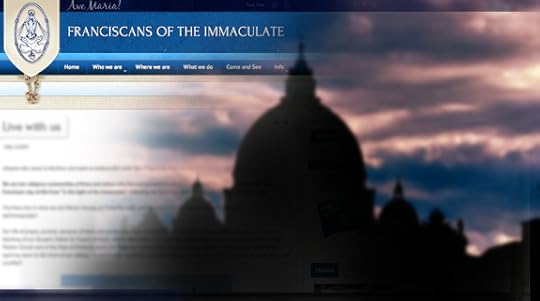
Hype and Hope for the FFI | Michael J. Miller | CWR
Separating wheat from chaff in the current controversies surrounding the Franciscan Friars of the Immaculate
Pity the poor Franciscan Friars of the Immaculate, persecuted by heartless bureaucrats who despise all things preconciliar! Weep for their Superior General, put under house arrest, his councilors banished to earth’s remotest ends! Woe to the Vatican commissar, systematically demolishing the community, its charism, and its apostolic works!
Victimization by the authorities makes for gripping headlines. Since Capuchin Father Fidenzio Volpi was appointed in July 2013 as Apostolic Commissioner to govern the FFI temporarily, the Italian press has publicized a steady stream of serious accusations: the spokesman for the community had acted treacherously and exceeded his authority; severe penalties were imposed on the aged founder, Father Stefano Manelli, without due canonical process. French-, German-, and English-language traditional Catholic websites and blogs have spread the stories as proof positive that insidious forces in the Vatican Curia are dead-set on eradicating the Extraordinary Form of the Roman Rite.
Curiously absent from all these accounts is any explanation grounded in fact of the actions taken by the Apostolic Commissioner in governing the FFI. Seemingly harsh decisions made by Father Volpi are reported, but not his own stated reasons for those decisions. Instead, every real or perceived slight, setback, inconvenience, or disciplinary measure is ascribed to hostility toward the traditional Latin Mass and those devoted to it.
The axiom “Audiatur et altera pars” applies here: “The other side deserves a hearing.” This article calls attention to some basic facts that have been overlooked in the media hype and summarizes Father Volpi’s written responses to a number of objections and accusations. The source material used is the Italian-language documentation—survey results, press releases, open letters, clarifications—posted at the order's website, www.immacolata.com.
Note that Catholic World Report respects the confidentiality of internal communications of the Apostolic Commissioner with the Franciscan Friars of the Immaculate and will neither publish nor comment on their contents, unless and until such documents are posted on the official website of the religious community.
Background information
The Institute of Franciscan Friars of the Immaculate was founded in 1970 by Father Stefano M. Manelli and Father Gabriel M. Pelletieri, who were then Conventual Franciscan Friars.
December 15, 2013
Pope Francis' Missionary Church
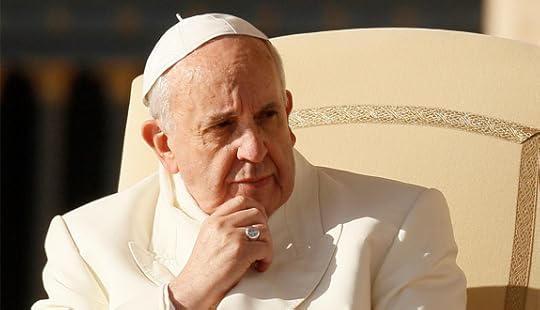
Pope Francis' Missionary Church | Fr. James V. Schall, S.J. | CWR
The Pontiff's focus (and impatience) is “this-worldly,” but it is not “utopian” or modernist
“Each Christian and every community must discern the path that the Lord points out, but all of us are asked to obey his call to go forth from our own comfort zone in order to reach all the ‘peripheries’ in need of the light of the Gospel.”
— Pope Francis, The Joy of the Gospel, #20.
“The kingdom is here, it remains; it struggles to flourish anew. Christ’s resurrection everywhere calls for the seeds for that new world, even if they are cut back, they grow again, for the resurrection is already secretly woven into the fabric of this history, for Jesus did not rise in vain. May we never remain on the sidelines of this march of living hope?”
— Pope Francis, The Joy of the Gospel, #278.
I.
When I finished Pope Francis’ first encyclical, The Light of Faith, I concluded that Francis’ pontificate would concentrate on the parish, on local communities and dioceses as centers of worship, belief, and charity. The Church would be less in the public eye. This example of a vibrant local life would be the basis of the attraction of Christianity to the Gentiles.
On finishing Pope Francis’ Apostolic Exhortation, The Joy of the Gospel, however, I have to conclude differently. Francis is concerned with an active, “missionary” Church that is very much involved with everything else through its attention to and delight in its own communal life. Time Magazine’s making Francis the “Person of the Year” is enough to tell us that Pope Francis’ short pontificate so far has not been a quiet affair to which few have paid attention. From the moment of his election, Francis came on not so much as a tiny seed but as a full grown mustard tree, to adapt a famous parable.
Since the day of his election, Francis has often, sometimes daily, made headlines of one sort or another throughout the world. Most everyone has an opinion about him. No one can ignore him, not even those who would like to. He is obviously likeable. He appreciates community life. One of the Renaissance popes (Leo X, d. 1521) quipped to his brother: “God has given us the papacy, let us enjoy it.” I have the impression that, in the best sense, Francis has enjoyed being pope. He seeks to know everyone. He drives his security forces crazy. But he has an exuberance that is catching. And he has something to say and he says it; let the chips fall where they may. He tells everyone he loves them. He tells us that he is a “sinner.” He does not think he is always right. He thanked Archbishop Marchetto for correcting him on the issue of the continuity of the Church before and after Vatican II.
Aside from The Light of Faith, which had Benedict XVI in its background, we have seen very little of Francis’ overall thought. He has a sparse paper-trail. He gives short, familiar homilies in Santa Marta’s chapel, each with three points. His Wednesday audiences and talks in L’Osservatore Romano are generally short and homey. He affirms every settled doctrine of the Church, but wants to present it gently, in a new context. What he says is always full of personal comment. We know much of his experiences in Argentina. They loved him in Rio at World Youth Day. Several of his interviews have gained worldwide attention and sharp controversy.
The Pope clearly wants to shift the attention of the Church to a missionary, outgoing mode.
Evangelii Nuntiandi: “The greatest pastoral document that has ever been written”
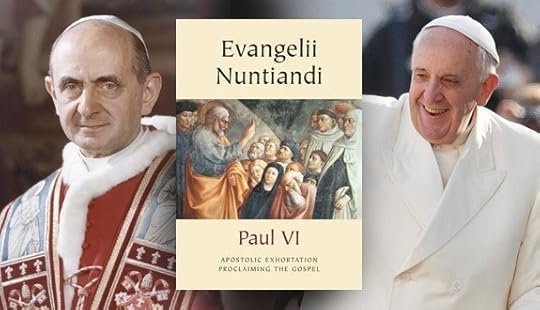
Evangelii Nuntiandi: “The greatest pastoral document that has ever been written” | J. J. Ziegler | CWR
Pope Francis has been candid about his appreciation for Paul VI’s 1975 apostolic exhortation. Many theologians and evangelization experts agree that the document has remained relevant and challenging to the Church today.
Readers of Blessed John Paul II’s documents have noted his frequent references to a sentence in Gaudium et Spes, the Second Vatican Council’s Pastoral Constitution on the Church in the Modern World: “man, who is the only creature on earth which God willed for itself, cannot fully find himself except through a sincere gift of himself” (no. 24).
Similarly, readers of Pope Francis’ writings have observed his frequent references to Evangelii Nuntiandi,Venerable Paul VI’s 1975 apostolic exhortation on evangelization. Pope Francis has cited it at least 31 times on at least 11 different occasions, including 13 times in his new apostolic exhortation Evangelii Gaudium. Evangelii Nuntiandi is an important part of the soil from which the teaching of Evangelii Gaudium has sprung; to use another image, they are akin to two plates of a diptych.
On May 17, Pope Francis said that Evangelii Nuntiandi included words that “are as timely as if they had been written yesterday”; on June 13, he called it “a very full text that has lost nothing of its timeliness”; and on July 27, as he spoke about evangelization, he called the document“that basic point of reference which remains relevant.” On June 22, he went so far as to describe it as “to my mind the greatest pastoral document that has ever been written to this day” (“per me il documento pastorale più grande che è stato scritto fino a oggi”).
Popular culture and religious climate have changed much since Pope Paul wrote Evangelii Nuntiandi in 1975; in the United States that year, Captain & Tennille’s “Love Will Keep Us Together” was the most popular song, Jaws was the highest-grossing film, and E.L. Doctorow’s Ragtime was the bestselling novel. According to a Gallup poll taken that year, 44 percent of Americans had a “great deal” of confidence in “the church or organized religion”; 24 percent had “quite a lot” of confidence, 20 percent had “some,” 9 percent had “very little,” and only 1 percent had “none.” Fifty-four percent of Catholics and 40 percent of Protestants said they had attended church during the past seven days.
While much has changed since 1975, several Catholics recognized for their expertise in evangelization agree wholeheartedly with Pope Francis’s assessment of the importance and continued relevance of Evangelii Nuntiandi.
“Other than the Bible and the Catechism, Evangelii Nuntiandi has been the most fundamental source of formation as well as personal and organizational renewal,” says Curtis Martin, founder and president of the Fellowship of Catholic University Students (FOCUS), a consultant to the Pontifical Council for the Promotion of the New Evangelization, and an auditor at the 2012 Synod of Bishops on the New Evangelization.
“Evangelii Nuntiandi has been and continues to be the impetus for getting out of my own comfort zone,” says Fr. John Hurley, CSP, executive director of the Office of Evangelization for the Archdiocese of Baltimore and a consultant to the United States Conference of Catholic Bishops’ Committee on Evangelization and Catechesis. “It is one thing to read and reflect on the Gospels and how they impact your life. But what part of ‘go [and make disciples]’ did we not get?”
Father Jim Wehner, rector of Notre Dame Seminary in New Orleans and also a USCCB evangelization committee consultant, recalls:
December 14, 2013
"St. John of the Cross" by Fr. Thomas Dubay, S.M.

St. John of the Cross | Fr. Thomas Dubay, S.M. | From Fire Within: St. Teresa of Avila, St. John of the Cross, and the Gospel--On Prayer
When we compare the amount of information available about the person of St. John of the Cross with what we have for many other saints, such as Teresa and John Vianney, we may say that we know both more and less. Concerning biographical data, concrete facts, historical happenings, we know less about the former than we do about the latter. From the extensive eyewitness accounts given for the canonization processes for the Curé of Ars and for Teresa of 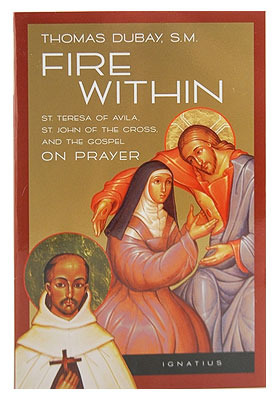 Jesus, we know a great deal about their daily activities and about how they appeared in the eyes of others. The latter also tells us much about herself in her autobiography, her Book of Foundations and the many letters that have survived. St. John of the Cross said nothing about his activities in his major works, and a mere handful of his letters have come down to us. However, we do know from other parties enough of his manner and deeds to form an accurate picture of his personality.
Jesus, we know a great deal about their daily activities and about how they appeared in the eyes of others. The latter also tells us much about herself in her autobiography, her Book of Foundations and the many letters that have survived. St. John of the Cross said nothing about his activities in his major works, and a mere handful of his letters have come down to us. However, we do know from other parties enough of his manner and deeds to form an accurate picture of his personality.
Yet in some ways we know much more about John than about other saints and other famous men and women. What we know so extremely well about him is what is most important about anyone: his deepest self. And because his inner life was so immensely rich, there is far more to know than what we find in the ordinary heroes and heroines of history. Though this saint seldom used the personal pronoun I in his writing, he is of course constantly revealing his inner depths. In this John is incomparable. There are few men or women in history who have combined in their persons the loftiest sublimity of love experiences with an extraordinary talent for describing them.
While we have already noted that a man's life activities and written words are mutual commentaries, we must add that this truth is especially pertinent to St. John of the Cross. His teaching is the unvarnished Gospel, neither more nor less, and to understand it rightly with neither exaggeration nor diminution we need to see in his manner and deeds how he himself applied it to the concrete circumstances of the daily round. His mode of life is likewise a silent but eloquent testimony of what is indispensable for deep prayer to be given and received.
What kind of man was this saint who is so seldom well understood? We may say that he was serene, plain, simple ... fearless of enemies but gentle toward everyone... intelligent and logical.. . outspoken but soft spoken. . . powerfully resolute and completely honest. moderate but by no means mediocre.. . uncompromising with principles but compassionate with human failings ... poetically brilliant but no weaver of euphemisms... hard on himself but tender with others.
John so loved nature that Peers called it his dominant interest on the natural plane. He enjoyed going outdoors and praying immediately from the book of creation lying before his eyes. It is said of him that he would be found in his cell with elbows on the windowsill, gazing, in absorbed prayer, upon the flowers during the day or the stars at night. That nature sparked a burning love for God in this man is shown likewise by the inspired imagery we find in his works. [87] That the saint also enjoyed a keen appreciation for music appears, for example, in the verse, "silent music, sounding solitude", of Spiritual Canticle.
People who know St. John of the Cross only superficially may consider his spirituality to be predominantly negative. That there is a prominent sacrificial element is true, just as there is in the Gospel. But what is not sufficiently understood is that in both John and the Gospel the negative is never sought for itself, and that the positive overwhelmingly predominates. That this is so we will consider in its proper place, but it may be well to note here that this man had an exceptionally affirmative, optimistic vision of both the human person and the divine plan. Even his nada doctrine was entirely aimed at reaching an enthralling immersion in God. The sanjuanist optimism can be seen, for example, in his portrayal of all creation as a resplendent bride given by the Father to the Son: "I will hold her in My arms and she will burn with Your love, and with eternal delight she will exalt Your goodness .... By these words the world was created, a palace for the bride." [88] It would be difficult to find in all of literature a more jubilant, a more positively ecstatic outlook on creation and the human person within it. The critics of John seem not to read this far or else not to absorb what he says. Optimism is found everywhere in the saint's writings, even in the most stark sections on detachment and self-denial. Always he invites the reader to an entire enthrallment, an abiding joy beyond imagining.
St. John of the Cross did not seem to excel in speaking to large groups of people with the effectiveness of a John Chrysostom or a Francis of Assisi, but he did have a powerful gift for relating to individuals and small groups in informal chats. Peers tells us that while he could easily be missed and passed over in a crowd, "once seen and spoken to alone, [he] could never be forgotten". [89] This charism, together with his uncommon grasp of the interior life, readily explains his popularity as a spiritual director. He was much sought after in this capacity by all sorts of people: laymen and laywomen, nuns, university students and their professors. His insights into Scripture were so well known and appreciated that professors at the university in Baeza consulted him to learn of these "new" explanations of the biblical word.
On the natural level it appears that John's greatest talent was his poetic genius. The Spanish scholars I have met and read are agreed that he is probably the greatest poet in the Spanish language. Kavanaugh and Rodriguez write that the saint is known as "the loftiest poet of Spain", not because of volumes upon volumes of verse but because of a mere handful often to twelve compositions. They add that "these compositions, however, display such variety that it can almost be affirmed that each of them represents a completely distinct poetic vision and technique, a singular accomplishment in Spanish literature". [90] E. Allison Peers considers John "a supremely skillful artist endowed in the highest measure with natural ability". Commenting upon the poetic perfection of Spiritual Canticle, this critic observes that
either his stanzas were kneaded, pulled to pieces and refashioned again and again in the cell of his mind--"polished and repolished ceaselessly" as the French preceptionist has it--or he was possessed of the most marvelously intuitive poetic faculty imaginable and developed what the Catalan Maragall was later to call the art of the "living word" (paraula viva) to an extent heretofore unknown. [91]
Peers notes the saint's extraordinary achievement of attaining to "the very highest rank of European poets" by a tiny output of a little over fifty stanzas. That this friar knew what love is all about can be witnessed even from the secular world, for he is considered "a poet's poet, whom in these days of a Spanish lyrical renaissance, contemporary singers revere as perhaps no other". [92] Citations, some even more superlative, could be multiplied, but we shall add only that the saint's literary genius was not confined to his poetry:
St. John of the Cross is also a poet in his prose, and the very abundance of his talent in this respect throws into sharper relief the austerity of his doctrine. The sum total of his merits as a writer of prose, of which its poetical quality is of course only one, constitutes a very remarkable achievement .... [Up to John's time] there had, in fact, been very little mystical prose at all, and that little had mainly been concerned with one aspect of mystical experience--the Prayer of Quiet. St. John of the Cross had therefore to invent phrases in order to express ideas which previously had had no outlet in Spanish. [93]

It surely had to be a singular work of divine providence that God would prepare as the prince of mystics a man who not only experienced abundantly the very highest gifts of prayer but also was endowed in the natural order with matchless literary talent and poetic power to express worthily, that is, beyond the inadequacy of prose, the raison d'être of being human, an intimate immersion in the indwelling Trinity.
However, as is the case with any man or woman, the most important thing about St. John of the Cross was not what he did but what he was. Sheer sanctity was his paramount trait. This man was on fire, utterly absorbed in God. He experienced ecstatic prayer even though he said almost nothing about the subject (because "Madre Teresa" had already so well said all that needed to be said about it), and he reached the transforming union while still a young man. The saint was capable of an absorption during meals such that he could not recall what he had eaten-much like St. Thomas Aquinas, who provided his own anesthetic for bleeding by the simple procedure of going into contemplative prayer.
As we would expect, John's transformation into the divine (understood, of course, in a nonpantheistic sense) showed itself in his active caring for others. The dire poverty of the nuns at the Incarnation convent while he was their confessor so touched his heart that he went out to beg alms for them, and he made a point of seeking delicacies for the ill. When his own friars were sick, the saint gave them exquisite care. If one of them had no appetite, John would suggest kinds of food he might like and then procure them immediately. He would rise at night to check on the welfare of an ill confrere even when another friar had volunteered or been appointed to watch at the bedside. We know that he had a special love for the nuns at Beas, and he showed it at least once by walking several miles out of the way to visit them. This affection appears likewise in letters addressed to them. In one he remarks how they will know from his coming visit that he has by no means forgotten them, and he refers to "the beautiful steps you are making in Christ, whose brides are His delight and crown". [94] Further on he speaks to them as "my beloved daughters in Christ", [95] and in another he assures them that their letter to him was a great comfort. [96] In still another he strives to lighten the burden of pain in one of these Beas nuns: "Do not think, daughter in Christ, that I have ceased to grieve for you in your trials and for the others who share in them." [97]
The depth of John's love for his fellowmen can perhaps be best seen in two incidents the outside world would not have noticed at all. We understand those incidents adequately only when we recall the saint's uncompromising teaching on and practice of detachment from every single selfish desire. He had an extraordinary love for Francisco, his blood brother who was himself a mystic and remarkably holy. The saint called Francisco his most loved treasure in the world. When this brother once visited John and had decided to leave after two or three days, John told him not to be in so much of a hurry and to remain on for a few more days. [98] The other incident illustrates both the saint's fondness for St. Teresa and his insistence that no self-centered egoism is to be permitted in any event, even if another- saint is the object of it. I refer to John's finally deciding to destroy the letters from her that he had saved. It is easy to imagine the terrible pull in his sensitive heart. On the one hand he knew the goodness resulting for both parties from a friendship entirely immersed in God. He knew, too, that he and Teresa loved each other dearly and purely. But he also knew that there could be danger, not in their case of any obvious sin, but of slight, impercep- tible clingings that could result from retaining a packet of letters. Peers' comment is interesting:
I have always thought, for example, when rereading the letters in which St. Teresa refers to St. John of the Cross and trying to realize what the two must have been to each other, that few things he did in his life can have been harder than the burning of a bundle of her letters to him--probably all he had ever had from her. [99]
In tracing out the traits of this saint, we may not omit a few words about a characteristic that we would hardly expect in a man so widely known both in name and in teaching for devotion to the Cross. I refer to John's gentleness. Serene, calm, at peace in his own personal life even under harsh, cruel persecution, John did not retaliate, did not deal brusquely, rudely or severely with others. He was clement, indulgent, benign and forgiving. Unwittingly he gave us a portrait of his own manner when he sketched out his counsels on how all of us are to behave under duress. "A soul enkindled with love is a gentle, meek, humble, and patient soul", he observed. "A soul that is hard because of its self-love grows harder." [100] People deeply in love with God invariably grow in a habit of amiable and compassionate responses to those whom God Himself loves. "Keep spiritually tranquil in a loving attentiveness to God," advised John, "and when it is necessary to speak, let it be with the same calm and peace." [101] Virile and brave though he was, the saint showed this same humane compassion for others in the very imagery he chose in his writings:
It should be known, then, that God nurtures and caresses the soul, after it has been resolutely converted to His service, like a loving mother who warms her child with the heat of her bosom, nurses it with good milk and tender food, and carries and caresses it in her arms. [102]
Chrisogono tells us that a young woman wishing to go to confession but knowing John's reputation for an austere life approached him with a fear bordering on panic. She drew from the saint the observation that a confessor who is holy ought not to frighten people. Disclaiming holiness in himself, he nonetheless went on to remark that "the holier the confessor, the gentler he is, and the less he is scandalized at other people's faults, because he understands man's weak condition better". [103]
Perhaps the surest mark of sanctity is the hearing of piercing suffering with much love, first for God and secondly for those inflicting the pain. It is easy for most of its to appear humble, patient, modest and loving when the sun shines, when others commend us, when we succeed, when we are healthy, when the way is clear of obstacles. What man or woman really is shines forth under contradiction, failure, illness. Any biography will make plain that John lived throughout his life the title he bore and the doctrine he taught. One example must suffice. While he was imprisoned for the second time by the calced friars, he was verbally abused and whipped on two occasions. He lived in a cell that was six feet by ten, with boards on the floor as his bed. There was no window, only a two-inch opening at the top of the wall facing the corridor. It was so cold during the winter that the skin on his toes came off from frostbite. His food was bread, water and sardines. He was administered the periodic "circular discipline", so called because each of the eighty members of the community took turns in lashing his bare back. He bore through life the scars of this brutal punishment. During and after these nine months of dark solitude and torture, John uttered not a single complaint and bore no resentment toward his captors. [104] One could see the image of the Crucified in him.
But the saint's affliction and agonies suffered at the hands of others did not satisfy his thirst to imitate the Master in his Passion. It is worthy of notice that while John says almost nothing in his writings about external penances, he practiced a great deal of them in his personal life. While he was prior at El Calvario monastery, he was first among the friars to set to menial tasks such as washing dishes. As prior of Los Martires he chose the narrowest and poorest cell in the monastery as his dwelling. He slept on "handfulls of rosemary twigs interwoven with vine shoots" and later used bare boards as his bed. [105] John wore a penitential chain so tightly around his waist that when it was later pulled away during an illness, the links were found to be embedded in his flesh. [106] Because the saint loved music so much and because during his final illness he was suffering intensely, a layman, Pedro de San José, thought he might soothe John's discomfort by bringing in some musicians. The response of gentle John was typical both of his kindliness and of his love for the Cross:
Brother, I am most grateful for the kindness you wished to do me; I appreciate it very highly; but, if God has given me the great sufferings I am enduring, why wish to soothe and lessen them by music? For the love of Our Lord, thank those gentlemen for the kindness they had wished to do me: I look upon it as having been done. Pay them, and send them away, for I wish to endure without any relief the gracious gifts which God sends me in order that, thanks to them, I may the better merit. [107]
The reader who wishes to develop a deeper appreciation for this remarkable man may consult the three books on John referred to in the footnotes to this chapter. We may for now be content with the judgment of our other saint. Teresa puts the whole matter in a nutshell in brief excerpts from two of her letters. Of Friar Juan de la Cruz she writes that "he is a divine, heavenly man .... You would never believe how lonely I feel without him .... He is indeed the father of my soul" [108] "People look upon him as a saint, which, in my opinion he is and has been all his life." [109]
Endnotes:
[87] See, for example, our Chapter 4, "Creation and Meditation".
[88] Romances 3 and 4, Creation, KR, pp. 726-27.
[89] E. Allison Peers, Spirit of Flame (New York: Morehouse-Gorham, 1945), p. 110.
[90] KR, Complete Works of St. John of the Cross, p. 709.
[91] Spirit of Flame, p. 136.
[92] Ibid., p. 138.
[93] Ibid., p. 139.
[94] Letter 6, p. 687.
[95] Ibid., p. 688.
[96] Letter 7, p. 688.
[97] Letter 8, p. 689.
[98] Crisogono of Jesus, O.C.D., The Life of St. John of the Cross (New York: Harper and Brothers, 1958), p. 268.
[99] Spirit of Flame, pp. 111-12.
[100] Sayings of Light and Love, nos. 27 and 28, p. 669.
[101] Maxims, no. 3, p. 674.
[102] Dark Night of the Soul, bk. 1, chap. 1, no. 2, p. 298.
[103] Crisogono, p. 128.
[104] See Crisogono, pp 103-5, and Bruno of Jesus and Mary, O.C.D., St. John of the Cross (New York: Sheed and Ward, 1932), pp 169-70.
[105] Crisogono, p. 128.
[106] Ibid., p. 239.
[107] Bruno, pp. 347-48.
[108] Letter 261, p. 625.
[109] Letter 240, p. 496.
Related IgnatiusInsight.com Articles:
• Seeking Deep Conversion | From Deep Conversion, Deep Prayer | Thomas Dubay, S.M.
• The Source of Certitude | Epilogue to Faith and Certitude | Thomas Dubay, S.M.
• The Confession of the Saints | Adrienne von Speyr
• The Measure of Literary Giants | An Interview with Joseph Pearce
 Fr. Thomas Dubay, S.M., is a well-known retreat master and expert in the spiritual life.
Fr. Thomas Dubay, S.M., is a well-known retreat master and expert in the spiritual life.
A Marist Priest, Father holds a Ph.D. from Catholic University of America and has taught on both major seminary level for about fifteen years. He spent the last twenty-seven years giving retreats and writing books (over twenty at last count) on various aspects of the spiritual life.
Ignatius Press has published several of his books, including Fire Within, Happy Are The Poor, Faith and Certitude, Authenticity, The Evidential Power of Beauty, and Prayer Primer. He has presented many series on EWTN, including an extensive study of the spiritual life of St. Teresa of Avila and a series on the life of prayer.
Awake! Repent! Rejoice!
A Scriptural Reflection on the Readings for Sunday, December 15, 2013 | Third Sunday of Advent | Carl E. Olson
Readings:
• Is 35:1-6a, 10
• Ps 146:6-7, 8-9, 9-10
• Jas 5:7-10
• Mt 11:2-11
First, awaken. Then repent. Now rejoice.
Those have been the central themes during these three Sundays of Advent. On the first Sunday, we heard Jesus exhort the disciples, “Therefore, stay awake!” Last Sunday we heard John the Baptist, the voice in the wilderness, preaching, “Repent!”
On Gaudete Sunday (from the Latin word for “rejoice”) we hear of joy, exultation, glory, and gladness. “Be strong,” declared the prophet Isaiah, “fear not!” Looking to the future, anticipating a time of peace and abundance, he gave several reasons for his call to joy. First, there is the “glory of the Lord, the splendor of our God.” Recognizing God’s existence and acknowledging his overwhelming beauty and power is foundational to any real joy; without this knowledge, joy is fleeting. Then there is God’s gift of salvation: “Here is your God, he comes with vindication; with divine recompense he comes to save you.” God is not just magnificent, he is magnanimous; he is not only great, he is giving. Finally, this gift of salvation is cause for everlasting joy for it means that we are meant to enter Zion, to come into his presence with thanksgiving—for all of eternity.
But no joy can be found if we are not awake; those who slumber cannot sing. And there is no joy for the sinner, for those who refuse to repent cannot be reborn or renewed. “The power of rejoicing is always a fair test of a man’s moral condition,” observed Archbishop Fulton Sheen, “No man can be happy on the outside who is already unhappy on the inside. … As sorrow is attendant on sin, so joy is the companion of holiness.”
Today’s reading from James anticipates one of the serious challenges for everyone who has awoken and repented and now waits: impatience. “Be patient, brothers and sisters,” writes James, who was addressing Christians dispersed outside of Palestine (cf. Jas. 1:1), “until the coming of the Lord.” He is emphatic on this point: “You too must be patient.” Impatience has a way of eating at our resolve, our hope, our sense of perspective. When impatience takes over, we are tempted to think we will be better off doing things our ways, in our time, and according to our wisdom. We begin to complain and our resolve wilts. Impatience let loose will eventually attack our faith and destroy our peace.
St. Teresa of Avila warned of this. “Hope, O my soul, hope”, she wrote. “You know neither the day nor the hour. Watch carefully, for everything passes quickly, even though your impatience makes doubtful what is certain, and turns a very short time into a long one. Dream that the more you struggle, the more you prove the love that you bear your God, and the more you will rejoice one day with your Beloved, in a happiness and rapture that can never end” (CCC, 1821).
But what of John the Baptist? Did he give into impatience? Today’s Gospel seems, at first blush, to suggest so. After all, the imprisoned prophet sent his disciples to Jesus, asking, “Are you the one who is to come?” But John, who never wavered in delivering his message or standing his ground, did this for the benefit of others. “John asks this not because he is ignorant,” explained St. Jerome, “but to guide other who are ignorant and say to them, ‘Behold, the Lamb of God, who takes away the sins of the world!’” They were attached to John, but they needed to be transformed by Christ. In sending them to Jesus, John was shaking them awake.
John the Baptist was a prophet—“and more than a prophet”—but he was not the Savior. He announced that the kingdom of heaven was at hand, but he was not the King. John’s greatness came from his faithful, joyful proclamation of the greatness of the Lord. Like him, we are called to rejoice in the glory, the gift, and the goodness of God.
(This "Opening the Word" column originally appeared in the December 12, 2010, issue of Our Sunday Visitor newspaper.)
20% off Pope Francis Titles from Ignatius Press!
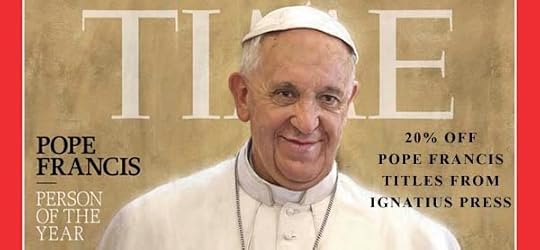
Offer ends Wednesday, December 18th, 2013 at 12:00 midnight EST.
20% off Pope Francis Titles from Ignatius Press! | These prices are available online only through Ignatius.com
"Bergoglio is quite mystical about his career choice, which hit him when he stopped off at church on his way to join friends to celebrate a holiday. 'It surprised me, caught me with my guard down,' he told Francesca Ambrogetti and Sergio Rubin, who interviewed him for their 2010 book, published this year in the U.S. as Pope Francis: Conversations with Jorge Bergoglio. 'That is the religious experience: the astonishment of meeting someone who has been waiting for you all along.'"
- Howard Chua-Eoan and Elizabeth Dias, "Pope Francis, The People’s Pope." TIME. 11 December 2013. TIME Web
Books
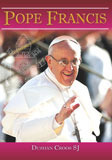 Pope Francis Biography
Pope Francis BiographyDushan Croos SJ
A short biography of the new Holy Father.
Amidst the many media reports on the newly elected bishop of Rome and his possible effect on the Church, it is easy to lose sight of who he is and where he really came from. This booklet gives you the facts.
In the brief time that the newly elected Pope Francis spent on the Balcony of St Peter's to greet his new diocese in Rome, many the world over were left asking who this man was who gave such a great impression of humility and approachability.
This newly written biography tells the story of Jorge Mario Bergoglio's journey from modest beginnings in Buenos Aires, through his studies in chemistry to formation in the Society of Jesus, then as Archbishop in Buenos Aires and finally to the See of Peter.
Set of 5 booklets, Regular price: $9.95, sale price: $7.96
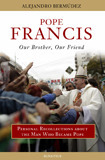 Pope Francis: Our Brother, Our Friend
Pope Francis: Our Brother, Our FriendAlejandro Bermúdez
This fascinating new look at Pope Francis presents the personal insights of ten Jesuits, many who have known him since his first days as a Jesuit, and were interviewed for this book shortly after he was elected the Pope. Some were his professors, some his peers, and some younger Jesuits who were his students. Also interviewed for this book are non-Jesuits, including an Argentine senator, a prominent rabbi, a priest working in the slums of Buenos Aires that Bergoglio often visited.
These interviews essentially transmit a mosaic that reveals little-known insights of the pontiff's personality, of his interior world, his human abilities, his work habits, his devotions, his concerns, and his friendships. Thus, they open a fascinating door to a better understanding of the man whom the Holy Spirit has elected to lead the Church at this time. Also available as an e-book.
Regular price: $19.95, sale price: $15.96
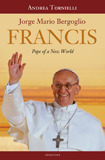 Francis: Pope of a New World
Francis: Pope of a New WorldAndrea Tornielli
In the words, the ideas, and the personal recollections of Pope Francis--including material up to the final hours before his election--the most highly regarded Vatican observer on the international scene reveals the personality of this man of God, gentle and humble. The son of Italian immigrants to Argentina, he made radically following Christ and the way of non-violence the pillars of his pastoral ministry in a country, continually tormented by social and economic inequities.
This complete biography offers the keys to understanding the man who was a surprise choice, even a kind of revolutionary choice, for pope. It is the story of the humble pastor of one of the world's largest archdioceses; a cardinal who takes the bus, talks with common folk, and lives simply. It is the story of why the cardinal electors of the Catholic Church set aside political and diplomatic calculations to elect a pope to lead the renewal and purification of the worldwide Church of our time. Also available as an e-book.
Regular price: $19.95, sale price: $15.96
Spanish Version: Jorge Bergoglio Francisco: La vida, las ideas, las palabras del Papa que cambiara la Iglesia
Regular price: $12.95, sale price: $10.36
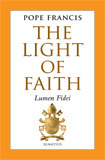 The Light of Faith: Lumen Fidei
The Light of Faith: Lumen FideiPope Francis
Faith is the source of light, of guidance for the Christian life. "We walk by faith, not by sight", wrote St Paul. In his first encyclical Pope Francis reflects on the meaning of faith, the beginning of God's gracious salvation.
Faith is the means by which man encounters the living God through Jesus Christ in the Holy Spirit. Francis draws on key themes of his predecessor, Pope Benedict XVI, who wrote encyclicals on charity and hope. He intended to complete the set with a reflection on faith, which would also have underscored the Year of Faith that he launched. Benedict's history-making retirement meant he was unable to finish his encyclical. Francis took up the task, adding his own insights, themes, and emphases to the work begun by Benedict XVI.
According to Pope Francis, Light of Faith is a "four hand document". Pope Benedict, Francis notes, "handed it to me, it is a strong document. He did the great amount of work". Thus, although officially Light of Faith (Lumen Fidei) is an encyclical of Pope Francis and reflects his teaching ministry, it is also reflects the work of Pope Emeritus Benedict. This is not only Francis' first encyclical; it is also the first encyclical to have been openly written by two successors of St. Peter.
Regular price: $14.95, sale price: $11.96
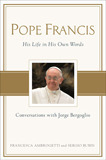 Pope Francis: His Life in His Own Words
Pope Francis: His Life in His Own WordsFrancesca Ambrogetti and Sergio Rubin
Elected in one of the shortest conclaves in history, the former Archbishop Jorge Mario Bergoglio of Argentina reveals, in a series of extensive interviews conducted over the course of two years, the very image of a humble priest, inspired teacher, and wise and adroit cardinal. What emerges is a portrait of a man more interested in substance over style, a compassionate cleric and teacher who has shunned the spotlight. In spontaneous, intimate terms, Archbishop Bergoglio, now Pope Francis, covers topics as wide-ranging as his childhood, family life, and the importance of his first job to discovering his calling and his early days in the seminary. The former archbishop was a teacher of psychology and literature until John Paul II consecrated him as a cardinal. He befriended writers like Jorge Luis Borges and cites Homer, Cervantes, and German and Italian poets with ease and offers nuanced thoughts about teaching. Thoughtful, intelligent, and even witty, he names Babette's Feast as his favorite movie and Marc Chagall as his favorite painter.
A learned and introspective man, he does not avoid the uncomfortable subjects: the declining numbers of priests and nuns; celibacy; the sexual abuse scandals that have rocked the Church; and his opinions about and experience with the military dictatorship of his own crisis-riddled country. It also discusses the incredible role he played in the last conclave, where he is said to have been tied with Ratzinger in the second of three votes, and asked that the votes for him be transferred to Ratzinger.
Through his own words, we come to know a man whose actions and words reflect his deeply-rooted humility. The book concludes with the Pope's own writings and reflections, full of wisdom and inspiration.
Regular price: $24.95, sale price: $19.96
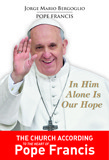 In Him Alone Is Our Hope
In Him Alone Is Our HopeJorge Mario Bergoglio (Pope Francis)
"Called from the end of the world," is he the shepherd who will lead the Church, confronted by the challenges of the postmodern world, along the pathway to renewal? Already his humble witness has made a powerful impact, giving us a glimpse of what is essential about him.... But deep down, who is this man? What does he think? Toward what shores will he steer the barque of Peter?
In this book, then-Cardinal Jorge Mario Bergoglio answers these questions himself as he preaches a retreat to the bishops of Spain. Following the spiritual exercises of Saint Ignatius of Loyola, he meditates upon the crucial issues at stake in the vocation of a bishop. In so doing, he offers us his vision of the Church, setting forth the outlines of what could well be the reform program of Pope Francis.
It is a rich, captivating text with a strong, uncompromising message. In short, it's a spiritual page turner you won't want to put down!
Regular price: $14.95, sale price: $11.96
Spanish Version: En Él solo la esperanza
Regular price: $14.95, sale price: $11.96
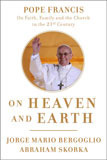 On Heaven and Earth
On Heaven and EarthJorge Mario Bergoglio and Abraham Skorka
From the man who became Pope Francis--Jorge Mario Bergoglio shares his thoughts on religion, reason, and the challenges the world faces in the 21st century with Abraham Skorka, a rabbi and biophysicist. For years Cardinal Jorge Mario Bergoglio, archbishop of Argentina, and Rabbi Abraham Skorka were tenacious promoters of interreligious dialogues on faith and reason. They both sought to build bridges among Catholicism, Judaism, and the world at large. On Heaven and Earth, originally published in Argentina in 2010, brings together a series of these conversations where both men talked about various theological and worldly issues, including God, fundamentalism, atheism, abortion, homosexuality, euthanasia, same-sex marriage, and globalization. From these personal and accessible talks comes a first-hand view of the man who would become pope to 1.2 billion Catholics around the world in March 2013.
Regular price: $22.00, sale price: $17.60
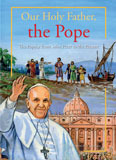 Our Holy Father, the Pope
Our Holy Father, the PopeDon R. Caffery
Who was the first pope? Who is the pope today? What does he do? And why do we need one anyway? The answers to these questions and more can be found in this beautifully illustrated book for children. Our Holy Father, the Pope takes us back to the time of Jesus so that we can learn about the origins and role of the Papacy.
The storybook format begins with the Gospels: Jesus calling Simon, Jesus renaming him Peter, meaning "rock", and giving him the keys to the kingdom, and so on. It follows Peter as Jesus suffers, dies, and rises from the dead for all mankind. The descent of the Holy Spirit, the birth of the Church, and the death of Peter himself for the sake of Jesus also are described.
The Church carries on with a new leader to replace Peter, as she has down through the centuries to our own day. As children will learn from this book, although the Church has adapted to the times, the tasks of our modern popes are not that different from those of Peter.
The book includes brief biographies of some famous popes, a list of all the popes from Peter to the present, and a bibliography.
Regular price: $14.95, sale price: $11.96
Films
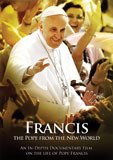 Francis: The Pope from the New World
Francis: The Pope from the New WorldOn March 13, 2013 the world was introduced to Pope Francis. He was the first Pope from the Americas, the first Jesuit, and the first to take the name Francis. Within days he had captured the hearts of the world through his gestures of humility and care for the common man. Yet he remained largely unknown.
Francis: The Pope From the New World unveils the personality, passion and extraordinary faith of the new Pope. Filmed on location in Buenos Aires, and featuring interviews with close friends, collaborators, and his official biographer this documentary traces the remarkable rise of Jorge Mario Bergoglio.
Regular price: $19.95, sale price: $15.96
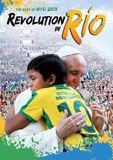 Revolution in Rio: The Best of WYD 2013
Revolution in Rio: The Best of WYD 2013
Revolution in Rio is a pulsating 55-minute documentary that will help you experience all the highlights of WYD in Rio de Janeiro in August 2013.
More than three million young people around the world responded enthusiastically to the invitation of Pope Francis, and you can experience that incredible enthusiasm of youth for the challenges presented by the charismatic Pope. Six unforgettable days synthesized in 55 intense minutes that mix humor, fervor, cry and love in joyful symphony. With several wonderful bonus extras.
The film includes many "thriller" moments of celebration, art, and drama, with a dynamic soundtrack and interspersed with brief interviews of young people at WYD. It ends with the prophetic witness of Pope: "Christ is preparing a new springtime in the world".
The DVD also contains 50 minutes of Extras, including the top songs of World Youth Day, the Pope's special speech to young Argentines, a photo gallery, and an extract of the biography of Pope Francisco.
Regular price: $19.95, sale price: $15.96
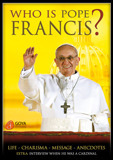 Who Is Pope Francis?
Who Is Pope Francis?This outstanding new documentary film just produced in Europe gives an excellent overview into the life, thought and work of Jorge Mario Bergoglio, formerly Archbishop of Buenos Aires and now Pope Francis. It contains previously unreleased recordings and endearing images of Cardinal Bergoglio. His words and actions convey the unique charisma of this surprise Argentine Pope whose humility, kindness and courage are winning countless admirers to a renewed interest in the Papacy. The film includes comments on the new Pope by the Provincial of the Society of Jesus in Argentina and Spain, and from a Spanish bishop on the spiritual exercises preached by Cardinal Bergoglio to the Bishops. The film also shows many inspiring images of the papal conclave , and the most emotional details of the first appearances of Pope Francis, sprinkled with humor and warm emotion.
Regular price: $19.95, sale price: $15.96
Art and Gifts
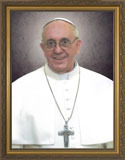 Pope Francis Formal Portrait 12" x 16"
Pope Francis Formal Portrait 12" x 16"Celebrate the election of our new Holy Father, Pope Francis, with this beautiful framed official portrait! This print is in a gold wood frame with non-glare glass. Proclaim your faith and proudly display this reminder of the head of Christ's Church on earth.
Regular price: $50.00, sale price: $40.00
Size 16" x 20" also available
Regular price: $100.00, sale price: $80.00
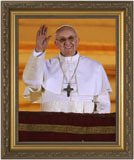 Pope Francis Arrives on Balcony Framed Image 12" x 16"
Pope Francis Arrives on Balcony Framed Image 12" x 16"Celebrate the election of our new Holy Father, Pope Francis, with this beautiful framed official portrait! This print is in a gold wood frame with non-glare glass. Proclaim your faith and proudly display this reminder of the head of Christ's Church on earth.
Regular price: $50.00, sale price: $40.00
Size 16" x 20" also available
Regular price: $100.00, sale price: $80.00
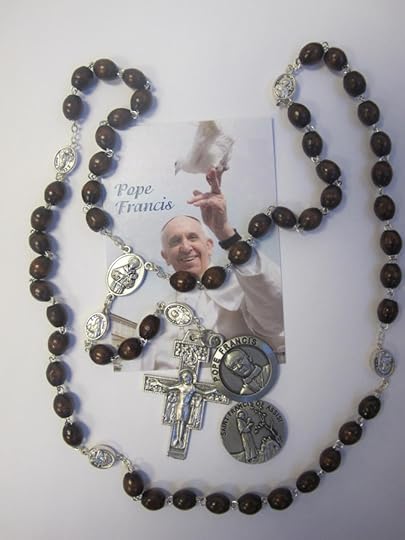 Pope Francis Rosary
Pope Francis RosaryThis five decade rosary is made of of dark brown oval 7 mm wood beads. The our father beads are silver plated medals with St. Francis on one side and of St. Clare on the other. The larger center also has St. Francis on one side and St. Clare on the other. The San Damiano crucifix measures 1 3/4" and is made of oxidized metal. Attached to the crucifix is a round pewter medal of Pope Francis on one side and beautifully detailed image of St. Francis preaching to the birds on the reverse.
Regular price: $14.95, sale price: $11.96
Catholic World Report
Why the Laity Matters
By Alvino-Mario Fantini
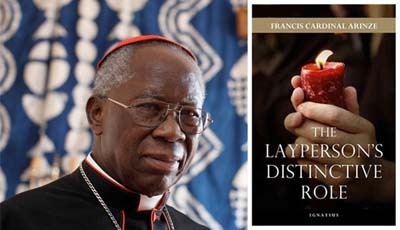
A review of Cardinal Francis Arinze’s new book, The Layperson’s Distinctive Role
I recently returned from visiting Croatia, where a controversial referendum was held on December 1 amending the constitution to define marriage as a union of a man and a woman. The results surprised many foreign observers: 66 percent of voters were in favor of the proposal.
Though some media outlets asserted that the campaign in support of the resolution was organized and promoted by “reactionary” officials from the Catholic Church, the truth is that the referendum and its results were all entirely the handiwork of grass-roots activists—mothers and fathers, young couples, and the mass mobilization of thousands of families of different faiths. In short, it was lay people—not priests or religious—who orchestrated it all ...
Homiletic and Pastoral Review
Understanding Pope Francis’ Apostolic Exhortation, “Evangelii Gaudium”
By Fr. David Vincent Meconi, SJ
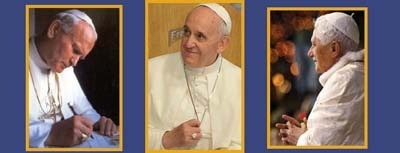
Evangelii Gaudium is ostensibly the Pope’s response to the Synod last October … but it is much more than a simple reporting on what happened there. It is the outlining of the key themes Pope Francis hopes will constitute his pontificate.
To understand Pope Francis, we might recall two scenes from the founder of the religious order who inspired the young Jorge Mario Bergoglio in the first place. St. Ignatius of Loyola (1491-1556) was once incarcerated by the Inquisition for suspected heresy; but Ignatius was also the one who coined the term “the hierarchical Church.” The young Inigo was misunderstood, and thus perceived as a threat as he wandered post-Reformation Europe giving his Spiritual Exercises. He encouraged believers to foster a deep “personal relationship” with the person of Jesus Christ in how they prayed scripture, and how they exercised charity in their everyday lives. Yet ...
Pope Francis' Missionary Church

Pope Francis looks on as he leads his general audience in St. Peter's Square at the
Vatican Dec. 11. (CNS photo/Paul Haring)
Pope Francis' Missionary Church | Fr. James V. Schall, SJ | CWR
The Pontiff's focus (and impatience) is “this-worldly,” but it is not “utopian” or modernist
“Each Christian and every community must discern the path that the Lord points out, but all of us are asked to obey his call to go forth from our own comfort zone in order to reach all the ‘peripheries’ in need of the light of the Gospel.”
— Pope Francis, The Joy of the Gospel, #20.
“The kingdom is here, it remains; it struggles to flourish anew. Christ’s resurrection everywhere calls for the seeds for that new world, even if they are cut back, they grow again, for the resurrection is already secretly woven into the fabric of this history, for Jesus did not rise in vain. May we never remain on the sidelines of this march of living hope?”
— Pope Francis, The Joy of the Gospel, #278.
I.
When I finished Pope Francis’ first encyclical, The Light of Faith, I concluded that Francis’ pontificate would concentrate on the parish, on local communities and dioceses as centers of worship, belief, and charity. The Church would be less in the public eye. This example of a vibrant local life would be the basis of the attraction of Christianity to the Gentiles.
On finishing Pope Francis’ Apostolic Exhortation, The Joy of the Gospel, however, I have to conclude differently. Francis is concerned with an active, “missionary” Church that is very much involved with everything else through its attention to and delight in its own communal life. Time Magazine’s making Francis the “Person of the Year” is enough to tell us that Pope Francis’ short pontificate so far has not been a quiet affair to which few have paid attention. From the moment of his election, Francis came on not so much as a tiny seed but as a full grown mustard tree, to adapt a famous parable.
Since the day of his election, Francis has often, sometimes daily, made headlines of one sort or another throughout the world. Most everyone has an opinion about him. No one can ignore him, not even those who would like to. He is obviously likeable. He appreciates community life. One of the Renaissance popes (Leo X, d. 1521) quipped to his brother: “God has given us the papacy, let us enjoy it.” I have the impression that, in the best sense, Francis has enjoyed being pope. He seeks to know everyone. He drives his security forces crazy. But he has an exuberance that is catching. And he has something to say and he says it; let the chips fall where they may. He tells everyone he loves them. He tells us that he is a “sinner.” He does not think he is always right. He thanked Archbishop Marchetto for correcting him on the issue of the continuity of the Church before and after Vatican II.
Aside from The Light of Faith, which had Benedict XVI in its background, we have seen very little of Francis’ overall thought. He has a sparse paper-trail. He gives short, familiar homilies in Santa Marta’s chapel, each with three points. His Wednesday audiences and talks in L’Osservatore Romano are generally short and homey. He affirms every settled doctrine of the Church, but wants to present it gently, in a new context. What he says is always full of personal comment. We know much of his experiences in Argentina. They loved him in Rio at World Youth Day. Several of his interviews have gained worldwide attention and sharp controversy.
The Pope clearly wants to shift the attention of the Church to a missionary, outgoing mode. He does not want anyone to stay at home.
Continue reading at www.CatholicWorldReport.com.
December 12, 2013
Chapter One of "María of Guadalupe: Shaper of History, Shaper of Hearts"

A Delectable Fruit of the Cactus for the Eagle | Paul Badde | Chapter One of María of Guadalupe: Shaper of History, Shaper of Hearts
With wood from the Santa Marla, Christopher Columbus built the first house in America. Hernán Cortés conquered Mexico. The growling of dogs on the beach and the dawn of the modern era lie heavy over the cities of New World and Old.
On the morning of August 3, 1492, sails billowing in the first wind, Columbus sailed from Andalusia in the Santa María, together with the Niña and the Pinta, in order, as he confides in the ship's log, to search for a westerly sea route to Jerusalem. If the names of his ships had been listed in another 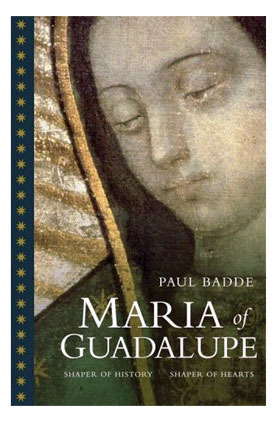 way, they would have made the phrase "Holy Mary (Santa María) paints (pinta) the girl (niña)". In itself, this would have been striking. However, this was only the beginning of the incredible story of the dark Lady, who, five hundred years after the discovery of America, still waits to be discovered by Europe, Asia, Africa and other parts of the world.
way, they would have made the phrase "Holy Mary (Santa María) paints (pinta) the girl (niña)". In itself, this would have been striking. However, this was only the beginning of the incredible story of the dark Lady, who, five hundred years after the discovery of America, still waits to be discovered by Europe, Asia, Africa and other parts of the world.
Historians say that, on Christmas night, 1492, the Santa María ran aground on a sandbar off of Haiti. Columbus decided to dismantle the grounded flagship and "build a fort out of what was salvaged". However, some years ago on the docks of the port of Barcelona, I saw an exact reproduction of the caravel Santa María. I doubt that with the planks and masts of this nutshell anyone could have managed to construct a fort. Two or three huts, perhaps, or a house—or even a small barricaded chapel. There was not enough material for more. The one thing that seems sure is that from the remains of the Santa María the first European house was raised in the New World. A year later it was pulled down and reduced to ashes.
Twenty-seven years later Hernán Cortés, a native of the city of Medellin, in Spain, disembarked from the Santa María de la Concepción onto the shore of the American continent. It was Good Friday of 1519, in the area of what would later become the port of Veracruz. A small expeditionary flotilla accompanied the Santa María de la Concepción . Two days later, Cortés asked two Franciscans, Diaz and Olmedo, to celebrate Easter with a high Mass on the beach. "The Spaniards planted a cross in the sandy ground", writes Francisco López de Gómara in his history of the conquest of Mexico. "They prayed the rosary and the Angelus as a bell was rung." To anyone familiar with Catholic liturgy, this seems somewhat confused. But there is no doubt that, after the liturgical service, Cortés, in a brief speech, took possession of an immense territory in the name of the Spanish Crown. Needless to say, the king of Castile was totally ignorant of who Cortés was and what he was doing there. The "Captain General" had taken on himself the responsibility of a royal commission.
Thus he resembled the immortal Don Quixote de la Mancha, who in Cervantes' book, written years later, would assume the fight against the forces of evil and defend the honor of the pure and lovable Dulcinea, who unfortunately existed only in the poor knight's addled brain and overheated imagination. But, unlike Don Quixote, "the Knight of the Woeful Countenance" with his nag Rocinante and his rusty lance, Cortés set upon his mission with a sharp sword and well-fed horses. Hernán Cortés' countenance was by no means woeful; he was an elegant man who dressed in silk and velvet . The natives could not comprehend what he might represent, and they observed in wonder the solemn ceremony of the occupation of Mexico. They were baffled as they observed these pale, well-armed men bow their heads and kneel before a wooden cross.
Along the coast, next to the conqueror's flagship, were anchored three other caravels and six small brigatines that had transported 530 men in the prime of their lives. They were natives of Spain, Genoa, Naples, Portugal and France. Among them were fifty sailors, the two Franciscans already mentioned, thirty crossbow-men and twelve harquebusmen. Among their armaments the expeditionary force had many swords and lances, sixteen horses, numerous Irish wolfhounds and mastiffs, ten long-range cannons, four falconets and various small Lombard cannons, as the new firearms were named in those days. Some of the men had mutilated ears—the punishment for those who had been caught robbing and convicted in Castile. Be that as it may, the gold chain around the neck of the self-proclaimed Captain General Cortés bore a medal with the Virgin Mary on the front and Saint John the Baptist on the back. On the mainmast of the flagship waved a golden pennant with a blue cross and the Latin inscription: "Amici, sequamur crucem, et si nos fidem habemus, vere in hoc signo vincemus": Friends, let us follow the cross . If we believe in it, truly in this sign we will conquer.
In spite of everything, a few weeks later, some of the conquistadors no longer held such a belief and had lost faith in the leader's good luck; they mutinied and took over a brigantine in order to sail back to Cuba. Cortés hanged two of the ringleaders, mutilated the foot of a third and had the rest publicly flogged. Then he gave orders that, with the whole expeditionary force looking on, nine ships should be grounded in the bay of Villa Rica, in order that even the most cowardly among them would have only one way open, through all their fears: the road to Tenochtitlan, the Aztec capital. In those days it was as large and as populated as ancient Naples or Constantinople and was even more beautiful than Venice. Cortés left only one ship in navigable condition, the Santa María de la Concepción. As all of this was going on, in far-away Europe Leonardo da Vinci was dying and the seven German electors were electing Charles I of Castile as Charles V of that Holy Roman Empire over which, it would later be said, the sun never set. With the addition of Mexico and the Philippines, this empire would cover the globe.
Within a mere two years of disembarking, Cortés had conquered the mighty Aztec empire. According to one variant, the word "Mexico" meant the "Land of the Moon". An actual conquest of the moon would not have come as a greater surprise. Nothing could have prepared the Europeans for the discovery of a New World or for the natives, whose human sacrifices terrified and revolted the Spanish adventurers from the first moment they witnessed the Aztecs take a flint knife to carve out the heart of a living victim and place it, still beating, on a black basalt altar as an offering to their god Quetzalcóatl. They called this the "delectable fruit of the cactus for the Eagle". Some of these altars of sacrifice to the Eagle still exist. After the conquest of Mexico, for example, the architects of the royal chapel nearby in Cholula imported them as holy-water fonts for the entryway.
Generally, before the sacrifice of members of the aristocracy, a drink of hallucinogenic mushrooms and a ration of obsidian wine would be given them—something, however, not disdained by many of the onlookers as well, whose deafening roars of laughter echoed unforgettably through the Spaniards' heads day and night. Less aristocratic or reluctant victims received nothing and were dragged up the pyramid by the hair. Because the priests drew blood from their own ear lobes as additional sacrifices, they were sinister-looking indeed. This was not all. They dressed in black; their hair was tangled; their faces ash-gray; their fingernails extravagantly long. Nothing could reconcile the Spaniards to Aztec sacrificial practices: not gold, not plaintive chants, not the gorgeous feathered vestments, not even the legendary magnificence of the Aztec cities. The blood-encrusted temple pyramids seemed to the Spaniards the very portals of hell.
In turn, to the Aztecs, the Spaniards' horses, which they called deer, seemed "as tall as the rooftops". The Spaniards entertained themselves by terrorizing the people with the horses' neighing, which they used tactically and strategically. This was a clash of cultures for which there was no precedent: Stone Age versus Iron Age; obsidian and flint versus Toledo steel; hauling by sled or teams versus the wheel; arrows versus gunpowder and cannonballs; and finally, the recklessly bold spirit of these Renaissance Christians versus the proverbial pagan anguish of the Amerindians, who were subject to an uncountable multitude of gods.


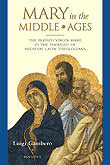







During the conquest of Mexico, from among the 1600 Spaniards, mostly latecomers to Cortés and his expedition, about one thousand died. But the Amerindian tribes who joined the conquistadors—the Tlaxcaltecans, for example, whom the Spaniards stirred up and set against the tyrannical Aztec people—mourned many more victims. The historian Hugh Thomas concludes about their combatants and victims as a whole that the Aztecs "had fought like gods" in the struggle but, in such an unequal contest, had perished by the hundreds of thousands. There had been prophecies that, in the year 1519, Quetzalcóatl, their feathered serpent-god, would return. The Aztecs had been waiting for him for generations. For this reason, some suppose that the Aztecs succumbed, not so much because of Spanish astuteness and their superior war machine, but rather because of an overwhelming surprise—and a profound disappointment.
Before and after the conquest of Mexico, not a single native Amerindian living on the islands of the Caribbean survived the Spanish invasion. For this reason, after their land was conquered, the situation seemed equally hopeless to the inhabitants of Mexico—Mexican, Mistecan, Cholulan, Toltecan, Chichimecan, Tlaxcaltecan, Xochimilcan, Totonacan and others. From here on we will refer to them simply as Aztecs, the name by which the Europeans identified the Amerindians who held sway over vast territories in Mexico at the time of the conquest. First, obviously, no dialogue between the cultures was likely to have been successful, even before the final victory of the military expedition, after Cortés kept the powerful ruler of Mexico, Montezuma II, under arrest in his own palace. Before he died under a rain of stones hurled by Aztec hands, a rain of stones that would erupt like a volcano against the Spaniards from their capital—before all this, the adventurer from Spanish Extremadura would sit for hours at night with the Aztec emperor, who before his accession to the throne had himself been high priest. He spoke to him not only about his sovereign, Charles, the sharpest "sword of Christendom" (to whom Cortés hoped to offer Montezuma's empire as a gift), but also about the ever-virgin Mother of God; about God: the Father, Son and Holy Spirit; about the Immaculate Conception; about the Incarnation; and about many other "interesting things". The sermons of this passionate conquistador and ladies' man were scarcely less bold than his conquest. This is something that sometimes surprises his biographers, and they refer to it frequently.
Nevertheless, for the Aztecs these sermons must have sounded more than strange. For on other days, in the plaza of the Great Pyramid, Cortés permitted the chained Aztec monarch to preside at the solemn burning of rebel Amerindian rulers. Montezuma himself did not stop having human sacrifices offered even while imprisoned. From the apex of the Great Pyramid drums sounded, as did conch horn, flutes and fifes made from bone. The earth had to keep revolving, and for this blood was needed. Also the many celebrations had to continue, and these could not be imagined in ancient Mexico without the human sacrifices that were "like flowers for the gods". The Aztecs had surrendered to bloodlust. The Florentine Codex relates that when his daughter reached the age of six or seven, an Aztec father would say to her: "An obsidian wind is blowing on us; it brushes us lightly and moves on; the earth is not a place of well-being; here there is no joy; here there is no happiness." Four hundred years later, Joseph Hoffner wrote: "A dark and bloody harshness weighed down the religion, a harshness that had deprived them of any cheerful lightness of heart." The Aztecs could not imagine life without war.
In the Old World, on the other hand, especially in Spain, not only were many real or presumptive heretics being burned at the stake, but also, in Germany, this was the time when the Reformation rose and took its course, which for the first time broke the Church apart into Catholics and Protestants, so that very soon eight million Christians had cut themselves off from Rome. No bonfire, no auto-da-fé, with its flames, could stop this revolution. In any event, the Emperor Charles V had enough to worry about without preoccupying himself with the adventures of one of his many foolhardy subjects in some faraway New World. The dawn of the modern era, with its attendant terrors, was on the horizon.
Simultaneously something occurred in Mexico that sounds more fantastic than the most sensational account of the conquest of the Aztec empire by Cortés and his men. It was the first apparition of the Queen of Heaven in the New World. No one with any regard for his intelligence would want to put faith in this phenomenon. Perhaps only now can the scope of this event be truly seen, because, better than ever before, we can now perceive how greatly this event has changed the course of history and the balance of the world.
Related IgnatiusInsight.com Articles and Book Excerpts:
• Mary in Byzantine Doctrine and Devotion | Brother John M. Samaha, S.M.
• Fairest Daughter of the Father: On the Solemnity of the Assumption | Rev. Charles M. Mangan
• The Blessed Virgin in the History of Christianity | John A. Hardon, S.J.
• "Hail, Full of Grace": Mary, the Mother of Believers | Joseph Cardinal Ratzinger
• Mary in Feminist Theology: Mother of God or Domesticated Goddess? | Fr. Manfred Hauke
• Excerpts from The Rosary: Chain of Hope | Fr. Benedict Groeschel, C.F.R.
• The Past Her Prelude: Marian Imagery in the Old Testament | Sandra Miesel
• Immaculate Mary, Matchless in Grace | John Saward
• The Medieval Mary | The Introduction to Mary in the Middle Ages | by Luigi Gambero
• Misgivings About Mary | Dr. James Hitchcock
• Born of the Virgin Mary | Paul Claudel
• Assumed Into Mother's Arms | Carl E. Olson
• The Disciple Contemplates the Mother | Erasmo Leiva-Merikakis
María of Guadalupe: Shaper of History, Shaper of Hearts 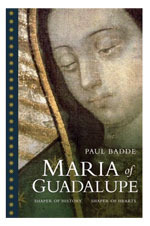
by Paul Badde
Mexico, December 9, 1531. Ten years after the Spaniards conquered this land, on a hill on the outskirts of the capital, something inconceivable happens to Juan Diego, a native of the area. At dawn a heavenly figure comes to meet him, revealing herself as "Mary, mother of all men". To confirm the first vision, the Lady not only entrusts him with several messages. But, also, in the final vision, leaves her portrait mysteriously present on his tilma. It is the portrait of a young woman looking downward. She is clothed in a dress figured with roses and a mantle spangled with stars.
From the time of its occurance this event has moved people. However, because of the fascination with the image itself, doubts have been raised, causing some to reject it altogether. This image of Our Lady of Guadalupe, along with the Shroud of Jesus in Turin, have possibly become the most mysterious images on earth. The more studies are made of the image and of the cloth, the more mysterious it all becomes, for believers and scientists alike.
In a hands-on investigation, Paul Badde has been delving into this mystery from a historian's point of view, but also with the growing wonder of a journalist who has stumbled across a fabulous treasure.
In this heartfelt report, Paul Badde tells the fantastic story of the apparition that changed the history of the world. Only in light of this mysterious event, can one explain why the inhabitants of Central and South American entered the Church so quickly. Mary of Guadalupe was the person who inserted a whole continent into Western Culture.
December 11, 2013
Watch trailer for "Faith of the Fatherless: The Psychology of Atheism"
The trailer for Faith of the Fatherless: The Psychology of Atheism by Dr. Paul C Vitz:
More about the book:
Faith of the Fatherless: The Psychology of Atheism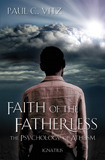
by Dr. Paul C Vitz
• Also available in Electronic Book Format
In this updated, expanded edition, starting with Freud's "projection theory" of religion - that belief in God is merely a product of man's desire for security - Professor Vitz argues that psychoanalysis actually provides a more satisfying explanation for atheism. Disappointment in one's earthly father, whether through death, absence, or mistreatment, frequently leads to a rejection of God.
A biographical survey of influential atheists of the past four centuries shows that this "defective father hypothesis" provides a consistent explanation of the "intense atheism" of these thinkers. A survey of the leading defenders of Christianity over the same period confirms the hypothesis, finding few defective fathers. Vitz concludes with an intriguing comparison of male and female atheists and a consideration of other psychological factors that can contribute to atheism.
Professor Vitz does not argue that atheism is psychologically determined. Each man, whatever his experiences, ultimately chooses to accept God or reject him. Yet the cavalier attribution of religious faith to irrational, psychological needs is so prevalent that an exposition of the psychological factors predisposing one to atheism is necessary.
Paul C. Vitz, is Professor/Senior Scholar at the Institute for the Psychological Sciences, Arlington, Va. and a Professor Emeritus of Psychology at New York University. He earned his bachelor's degree at the University of Michigan and his Ph. D at Stanford University. He was an atheist until his late 30s. Professor Vitz is the author/editor of a variety of books including: The Self: Beyond the Postmodern Crisis, Psychology as Religion: The Cult of Self-Worship, Sigmund Freud's Christian Unconscious, Censorship: Evidence of Bias in Our Children's Textbooks and numerous articles in professional and popular journals.
Praise for Faith of the Fatherless:
"Vitz offers a radical new thesis about the psychological origins of atheism. By studying the lives of numerous famous atheists, from the old atheists Nietzsche, Sartre, and Freud to the new atheists Hitchens, Dawkins, and Dennet, Vitz discovers a startling common pattern: atheism arises in people with dead, absent, or abusive fathers. By contrast, prominent defenders of religious belief-including Blaise Pascal, John Henry Newman, and G.K. Chesterton-were blessed with attentive, loving and caring fathers. Vitz's provocative book raises important questions about psychology, religious belief, and the importance of fathers."
- Christopher Kaczor, Author, The Seven Big Myths about the Catholic Church
"Quite simply, Paul Vitz's Faith of the Fatherless is a minor classic, a book that should be on the short list of all those who want to understand, in the deepest terms, the ill effects caused by the failures of fatherhood. Faith of the Fatherless should function as a gateway book to research in all fields examining our current, highly-secularized culture, a culture marked deeply by both unbelief and hostility toward the family and especially fatherhood."
- Benjamin Wiker, Author, Architects of the Culture of Death
"In deploying Freudian theory against atheism itself, Paul Vitz has proven beyond a doubt what's missing from secular accounts of secularization: namely, actual human beings. His thesis is intellectual jujutsu of the first order, as anyone reading this timely revisiting will appreciate in full."
- Mary Eberstadt, Author, The Loser Letters and Adam and Eve after the Pill
"Paul C. Vitz has republished one of the most profound books in the emperical psychology of religion, Faith of the Fatherless, now with additional data. Here he skillfully demonstrates objective analogies between the family experiences of articulate atheists and their pronouncements concerning the family of God. Of course, since there is "nothing" more personal than God-and our beliefs and relationships to God-our capacities for personal relationship matter tremendously in the formation of our divine beliefs. Everything is interconnected, we know. However, Prof. Vitz's engaging style makes his demonstration of these objective analogies especially memorable and useful for understanding unbelief and ourselves."
- Paul de Vries, PhD, President, NY Divinity School
"The reasons for belief in God and unbelief are complex and varied and hotly disputed. Paul Vitz makes a striking contribution to the current debate with an elegant and thoroughly plausible explanation for much atheism that turns the traditional Freudian critique of religion on its head. Relying on the biographies of well-known modern atheists, he finds significant evidence that negative childhood experiences with regard to one's father can severely compromise one's capacity to believe in God. Whatever one's beliefs, there is much to ponder in this well-written and well-researched book."
- Eric L. Johnson, PhD, Director, Society for Christian Psychology
Why the Laity Matters
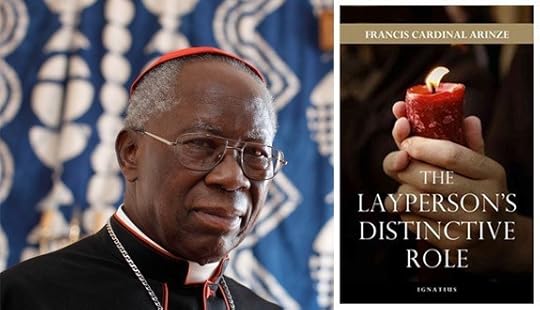
Why the Laity Matters | Alvino-Mario Fantini | CWR
A review of Cardinal Francis Arinze’s new book, The Layperson’s Distinctive Role
I recently returned from visiting Croatia, where a controversial referendum was held on December 1 amending the constitution to define marriage as a union of a man and a woman. The results surprised many foreign observers: 66 percent of voters were in favor of the proposal.
Though some media outlets asserted that the campaign in support of the resolution was organized and promoted by “reactionary” officials from the Catholic Church, the truth is that the referendum and its results were all entirely the handiwork of grass-roots activists—mothers and fathers, young couples, and the mass mobilization of thousands of families of different faiths. In short, it was lay people—not priests or religious—who orchestrated it all.
Cardinal Francis Arinze’s new book, The Layperson’s Distinctive Role, explores precisely this topic: the role of lay people in politics, society, and the Church. In this, it is a timely and necessary book.
Arinze begins by explaining that the word “laity” comes from the Ancient Greek word for people, laos, and describes some of the earliest forms of Christian communities that arose in the wake of Our Lord’s Passion and Resurrection. However, he stops short of offering a historical survey of the rise of religious orders and communities and, instead, focuses on the key documents of the Second Vatican Council (1962-1965) that clarified the duty, role, and apostolate of the lay faithful “in the Church and in the world.”
Arinze starts with a look at the main Church documents in which the role of the laity has been defined, clarified, and elaborated upon. These documents include those from the Council such as Gaudium et Spes, the Dogmatic Constitution on the Church Lumen Gentium, and the Decree on the Apostolate of the Laity Apostolicam Actuositatem. In addition, he considers various papal documents such as Pope Paul VI’s 1974 exhortation Evangelii Nuntiandi and Blessed John Paul II’s apostolic exhortation Christifideles Laici, issued after the 1987 Synod of Bishops on the vocation and mission of the lay faithful. These documents provide “the major orientation for our times on the role of the lay faithful in the Church and in the world,” according to Arinze.
Of course, this understanding of the layperson is quite modern.
Carl E. Olson's Blog
- Carl E. Olson's profile
- 20 followers







